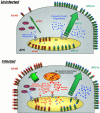CD8 T cell detection of bacterial infection: sniffing for formyl peptides derived from Mycobacterium tuberculosis
- PMID: 11369794
- PMCID: PMC2193328
- DOI: 10.1084/jem.193.10.f35
CD8 T cell detection of bacterial infection: sniffing for formyl peptides derived from Mycobacterium tuberculosis
Figures

Comment on
-
Induction of M3-restricted cytotoxic T lymphocyte responses by N-formylated peptides derived from Mycobacterium tuberculosis.J Exp Med. 2001 May 21;193(10):1213-20. doi: 10.1084/jem.193.10.1213. J Exp Med. 2001. PMID: 11369792 Free PMC article.
References
-
- Medzhitov R., Janeway C. Innate immunity. N. Engl. J. Med. 2000;343:338–344. - PubMed
-
- Prigozy T.I., Sieling P.A., Clemens D., Stewart P.L., Behar D.M., Porcelli S.A., Brenner M.B., Modlin R.L., Kronenberg M. The mannose receptor delivers lipoglycan antigens to endosomes for presentation to T cells by CD1b molecules. Immunity. 1997;6:187–197. - PubMed
-
- Hampton R., Golenbock D., Penman M., Krieger M., Raetz C. Recognition and plasma clearance of endotoxin by scavenger receptors. Nature. 1991;352:342–347. - PubMed
-
- Suzuki H., Kurihara Y., Takeya M., Kamada N., Kataoka M., Jishage K., Ueda O., Sakaguchi H., Higashi T., Suzuki T. A role for macrophage scavenger receptors in atherosclerosis and susceptibility to infection. Nature. 1997;386:292–296. - PubMed
Publication types
MeSH terms
Substances
LinkOut - more resources
Full Text Sources
Research Materials

